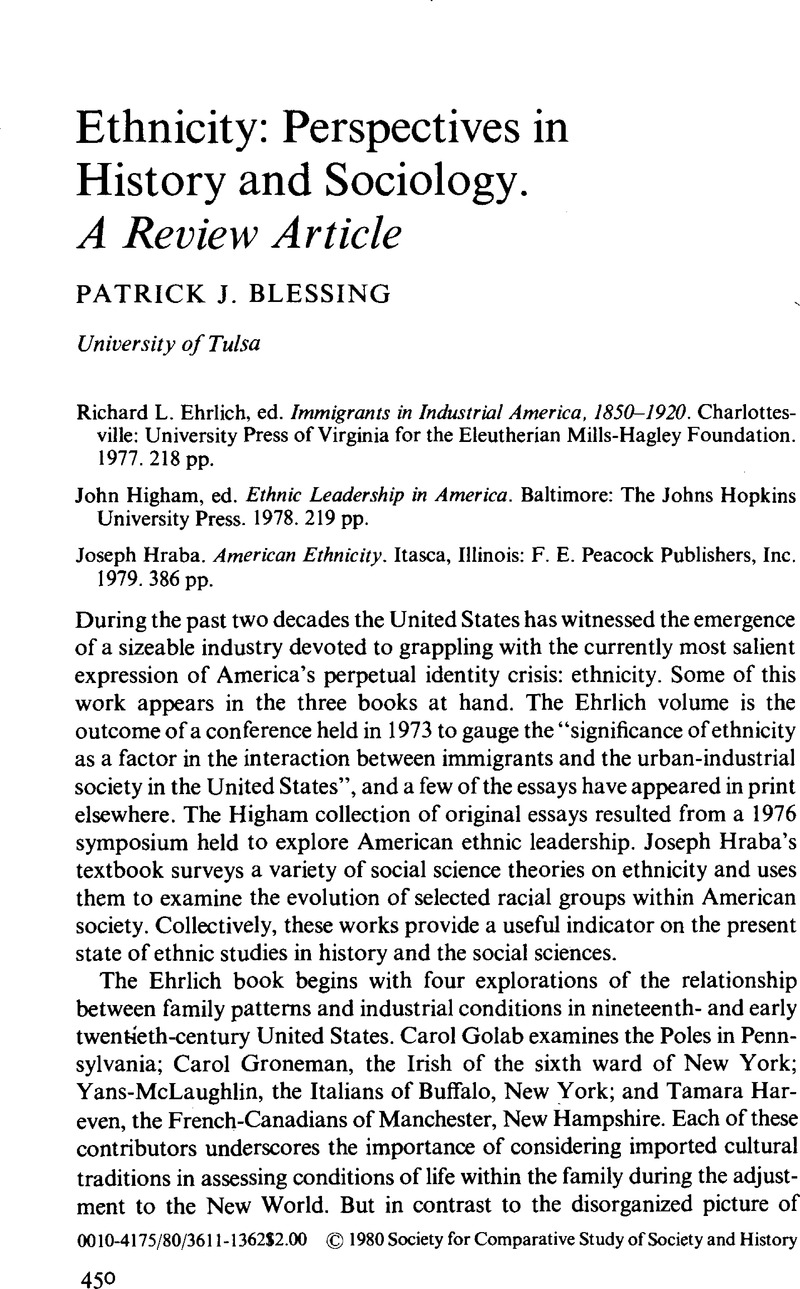No CrossRef data available.
Article contents
Ethnicity: Perspectives in History and Sociology. A Review Article
Published online by Cambridge University Press: 03 June 2009
Abstract

- Type
- Ethnic Elites
- Information
- Copyright
- Copyright © Society for the Comparative Study of Society and History 1980
References
1 Sullivan, Mark, The Education of An American (New York: Doubleday, Doran and Co., Inc., 1938), pp. 4–5;Google ScholarThomas, W. I. and Znaniecki, F., The Polish Peasant In Europe and America, 2 vols. (New York: Alfred A. Knopf, 1928).Google Scholar
2 Lieberson, Stanley and Fuguilt, Glenn V., “Negro-White Occupational Differences in the Absence “of Discrimination,” American Journal of Sociology, 73 (09. 1967): 188–200;CrossRefGoogle ScholarJohnson, Michael P. and Sell, Ralph R., “The Cost of Being Black: A 1970 Update,” American Journal of Sociology, 82 (07 1976): 183–90;CrossRefGoogle ScholarFarley, Reynolds, “Trends in Racial Inequalities: Have the Gains of the 1960's Disappeared in the 1970's?” American Sociological Review, 42 (04 1977): 189–208;CrossRefGoogle ScholarHanushek, Eric, “Ethnic Income Variations: Magnitudes and Explana- tions,” in Essays and Data on American Ethnic Groups, edited by Sowell, Thomas with the assistance of Collins, Lynn D. (Rutgers, New Jersey: The Urban Institute, 1978), pp. 139–66.Google Scholar For an assessment of ethnic differences in the quality of education, see Coleman, James S., et al. , Equality of Education Opportunity (Washington, D.C.: Government Printing Office, 1966).Google Scholar Individual differences which explain differences in income of Americans are explored in Jenks, Christopher, et al. , Inequality (New York: Basic Books, 1972).Google Scholar
3 Accurate data on the rate of Indian-white mixing in earlier times is difficult to obtain; for some suggestions of the extent of the phenomenon see Debo, Angie, And Still the Waters Run (Princeton: Princeton University Press, 1940), p. 47;Google Scholar and Walker, Deward E., “Measures of Nez Perce Outbreeding and the Analysis of Cultural Change,” Southwestern Journal of Anthropology, 23 (1967): 141–58.CrossRefGoogle Scholar Details on intermarriage today are provided by Office of Special Concerns, Department of Health, Education, and Welfare, , A Study of Selected Socio-Economic Characteristics of Ethnic Minorities, Vol. III (Washington, D.C.: Govern- ment Printing Office, 1975), pp. 35–37.Google Scholar
4 Sowell, Thomas, “Three Black Histories,” in Sowell and Collins, Essays and Data on American Ethnic Groups, pp. 7–48;Google Scholar see also, Sowell, , Race and Economics (New York: David McKay Company, Inc., 1975).Google Scholar
5 The logic behind this decision is given by Hraba on p. 201, to wit, “The problem is that Americans from Europe are so diverse, and their experiences in this country have been so varied, that it is impossible to write a chapter or two on the so-called white ethnic groups. In our opinion, Americans from Europe deserve an entire book, if only for their numbers and diversity.”
6 These essays are reprinted in Herbert Gutman, G., Work, Culture and Society in Industrial- izing America: Essays in American Working-Class and Social History (New York: Alfred A. Knopf, 1976).Google Scholar
7 See Mintz, Sidney, “Afterword,” in Higham, Ethnic Leadership, p. 199.Google Scholar
8 Ibid., p. 199.
9 See for example, Wilson, Woodrow, History of the American People (New York: Harper and Brothers, 1902), V, pp. 212–14;Google ScholarTurner, Frederick Jackson on Jews in the Chicago Record-Herald, 09 25, 1901,Google Scholar cited in Saveth, Edward N., American Historians and European Immigrants, 1875-1925 (New York: Russell and Russell, 1948), pp. 128–29.Google Scholar For a useful guide to some of these works see Gossett, Thomas F., Race: The History of an Idea in America (Dallas, Texas: Southern Methodist University Press, 1963), pp. 287–309.Google Scholar
10 For unfavorable images of the Irish see Curtis, L. Perry Jr., Apes and Angels: The Irishman in Victorian Caricature (Washington, D.C.: Smithsonian Institution Press, 1971);Google Scholar and Keller, Morton, The Art and Politics of Thomas Nast (New York: Oxford University Press, 1968);Google Scholar for expert coverage of images of the Japanese see Modell, John, The Economics and Politics of Racial Accommodation: The Japanese of Los Angeles, 1900-1942 (Urbana: Univer- sity of Illinois Press, 1977), pp. 11–12.Google Scholar See also Katz, Donald and Braly, K., “Racial Stereo- types in One Hundred College Students,” Journal of Abnormal and Social Psychology, 28 (1933): 280–90.CrossRefGoogle Scholar
11 Potter, David, “Explicit Data and Implicit Assumptions,” in Generalization in the Writing of History, edited by Gottschalk, Louis (Chicago: University of Chicago Press, 1963), p. 187.Google Scholar
12 Probably the most serious case of neglect of classic studies of the ethnic experience is the general absence of any reference to Thernstrom, Stephen, The Other Bostonians (Cambridge: Harvard University Press, 1973).CrossRefGoogle Scholar
13 The phrase is borrowed from Clifford Geertz who applied it to attempts to analyze a culture, but since ethnicity involves at least two cultures the phrase is even more applicable to ethnic studies. See Geertz, , The Interpretation of Cultures (New York: Basic Books, Inc., 1973), pp. 28–30.Google Scholar




